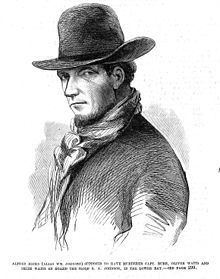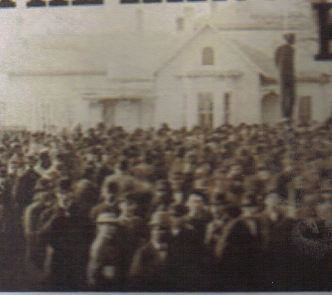Conviction(s) Piracy Name Albert Hicks | Criminal penalty Hanging | |
 | ||
Died July 13, 1860, New York City, New York, United States | ||
Albert W. Hicks (c. 1820 – July 13, 1860), also known as William Johnson, John Hicks, and Pirate Hicks, was a triple murderer, and the last person executed for piracy in the United States (though the execution of the slaver Nathaniel Gordon in 1862 was under the terms of the Piracy Law of 1820).
Contents

Criminal career
In March 1860, Hicks, a long-time deep-water sailor, was shanghai'd on to a ship as a member of an oyster sloop A.E. Johnson. Hicks, while sailing southward to buy oysters to be sold in New York City, attacked his perpetrators Captain George H. Burr and the two other crew members, brothers Smith and Oliver Watts with an ax, murdering them and then throwing the bodies overboard. During his escape, he collided with the schooner J. R. Mather.
The Captain George H. Burr and Oliver Watts retired to their quarters that night to catch some shut eye.
Smith had night duty as watch/lookout on the A.E. Johnson. While Hicks had control of the wheel. Smith had turned his back for a moment to look out near the starboard, this is when Hicks sought the opportunity to attack Smith from behind. Punching Smith repeatedly, Smith stumbled back and nearly fell overboard. Grasping the side of the ship hanging on for his life. Hicks then grabbed an axe used for chopping wood for the coal furnace and slashed Smith's right fingers off. Smith fell into the ocean and drowned.
After hearing the commotion of the fight, Oliver Watts jumped out of bed and exited his quarters. Finding that Hicks was alone and Smith nowhere to be found, Watts pulled his sword and began to attack Hicks. Hicks in retaliation then stuck Watts over the head with the axe.
Two crew members were dead and the Captain was still asleep in his quarters. Hicks decided to take control of the ship while he still had the opportunity. So Hicks entered the Captain's room. The Captain was a very tall, big guy and Hicks fought for an hour with him but eventually cut the Captain's throat entirely. After killing the captain he searched his living quarters for loot.
Hicks then took all the money on board (about $500) and abandoned ship in a yawl, landing on Staten Island. When the abandoned A.E. Johnson was brought ashore, with the murder victims' blood still very much in evidence, Hicks’s day of reckoning neared. After being pursued by authorities through several states, he was captured in Providence, Rhode Island and found to be in possession of the watch of Captain Burr, several money bags, and a coat of Watts's containing a daguerreotype belonging to Oliver Watts.
Confession
Hicks confessed to the three murders, and also claimed to have killed 97 others in California gold camps, as well as having committed a similar piracy in South America. He gave his reason as "...the devil took possession of me."
"The affair occurred," said Hicks, "about half past nine or ten o'clock at night, while Captain Burr and one of the Watts boys were asleep in the cabin. I was steering at the time, and the other Watts was on the lookout at the bow. Suddenly the devil took possession of me, and I determined to murder the captain and crew that very night. Creeping forward softly I stole upon the boy at the bow, and with one blow knocked him senseless. I believe he died in a few minutes after I struck him. The noise attracted the attention of the other Watts, who jumped out of bed, and came up the companion way to see what was the matter. Just at that moment I struck him a heavy blow on the head with the axe and soon he was dead. Then I went down in search of the captain, and upon going into the cabin we immediately came in contact. Captain Burr, who was a strong, able bodied man fought hard with me for several minutes; but at last I brought him down, and he, too, was soon dead. After rifling the captain's money bags, I commenced to throw, the bodies over board. They had been dead about an hour at this time, and sank into the sea the minute I threw them over the rail.
The knife marks found on the gunwale of the sloop were not made by me. I had no occasion to make them, as the men had all been dead an hour, and could not have clung to the rail, as was supposed. I should think we were about fifty miles at sea at the time, so that it was improbable that any of the bodies will ever be recovered. While I was on board the sloop the devil was always by my side and sustained me, but while I have been locked up here he has deserted me, and I feel bad."
Aftermath
He was executed by hanging, on Bedloe's Island, now known as Liberty Island. An estimated ten thousand people viewed the event from boats anchored in New York Bay. His last wish was to see the steamship Great Eastern, the world's largest passenger ship at the time, which was docked in New York. Soon after his burial, grave robbers stole his body. Some thought that he had survived, but his body was actually sold to medical students.
In popular culture
A ballad was written about him by Henry Sherman Backus, titled Hicks the Pirate in March 1860. P. T. Barnum’s American Museum featured a wax image of Hicks. Barnum also arranged for Hicks to be hanged in a silk pirate costume, which he later charged admission to view.
His name became a slang gambling phrase, meaning "Six on a pair of dice."
He was portrayed as a wax figure who apparently comes to life and commits a murder, in The Twilight Zone episode "The New Exhibit".
Historical research discrepancies
There are several discrepancies between this account and that found in Herbert Asbury's classic crime history The Gangs of New York - an Informal History of the Underworld (1928, Alfred A. Knopf, Inc.)
Most notably, Ashbury gives Hicks's name as "Albert E. Hicks" (not "Albert W. Hicks") and says that he commonly went by the nickname of "Hicksey".
Furthermore, Ashbury say that the name of the sloop was the "E.A. Johnson" (and not the "A.E. Johnson").
He also says that "four human fingers and a thumb" were found on the deck of the sloop. And that in his confession Hicks said that after "decapitating" the second Watts brother and driving his axe "deep into the side of the captain's head", that he "went on the deck where he found the Watts boy he had first assaulted struggling to his knees. The gangster [i.e., Hicks] knocked him down and then carried his body to the rail, where he hoisted the lad over the side of the sloop. But young Watts clutched the rail, whereupon Hicks raised his axe and calmly cut off his thumb and fingers, and Watts fell into the sea. Hicks then threw the other bodies overboard..."
And regarding P.T. Barnum's role, Ashbury writes that "Among the first [visitors to Hicks while he was held in "the Tombs"] was... Barnum, [who] asked for a private conference with the prisoner, which Hicks granted ... Barnum informed the pirate that he wished to obtain a plaster cast of his head and bust for exhibition in [Barnum's] Museum ... and after an entire day of haggling an argement [sic] was reached whereby Hicks agreed to pose in return for $25 in cash and two boxes of five-cent cigars. Early next morning the cast was made, and that afternoon Barnum returned to the Tombs with a new set of clothes, which he traded to Hicks for the one the pirate was then wearing. Later Hicks complained to the Warden that Barnum had cheated him, for the new garments were shoddy and not nearly so good a his old ones."
